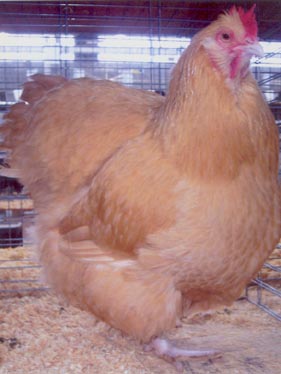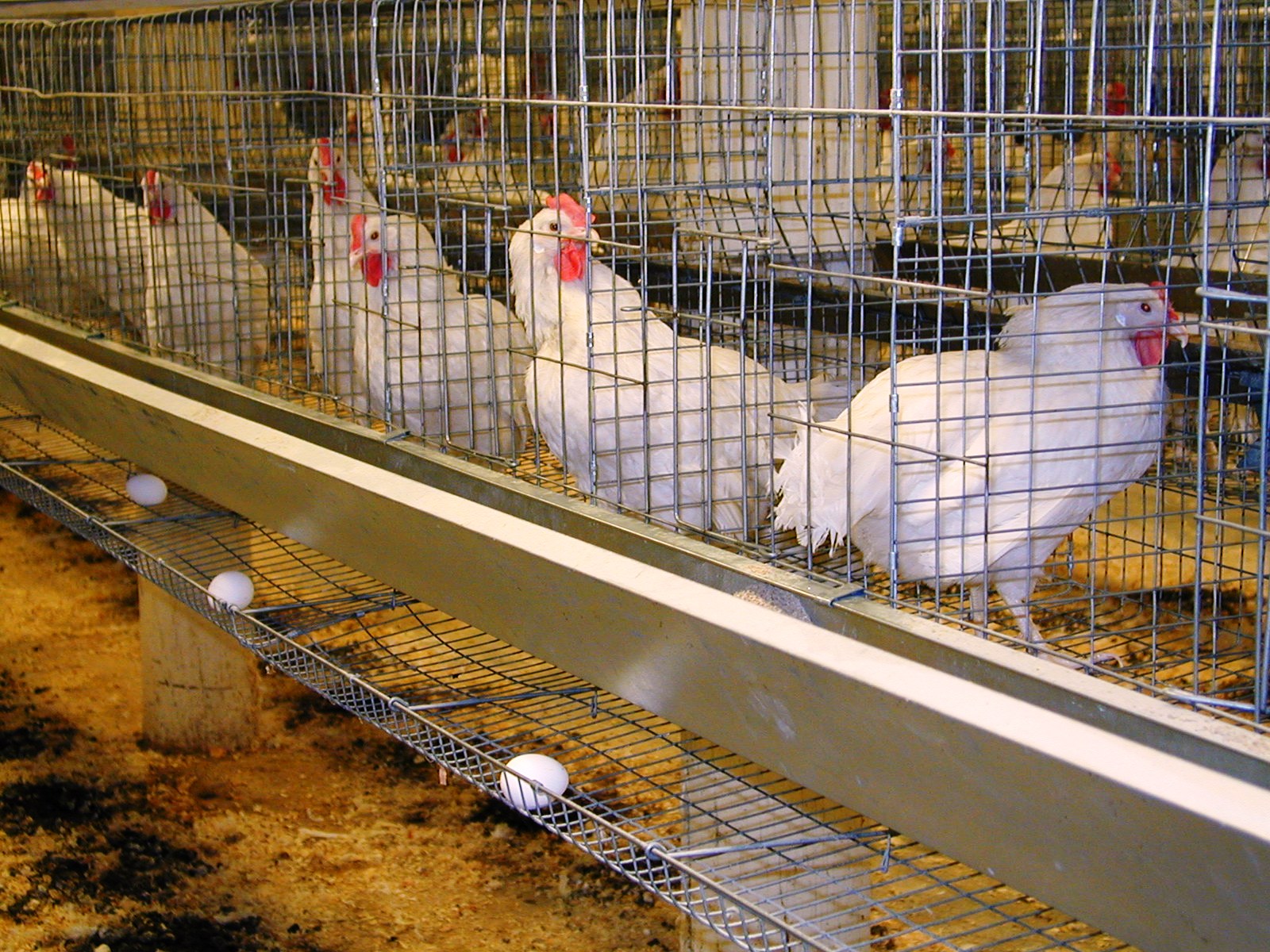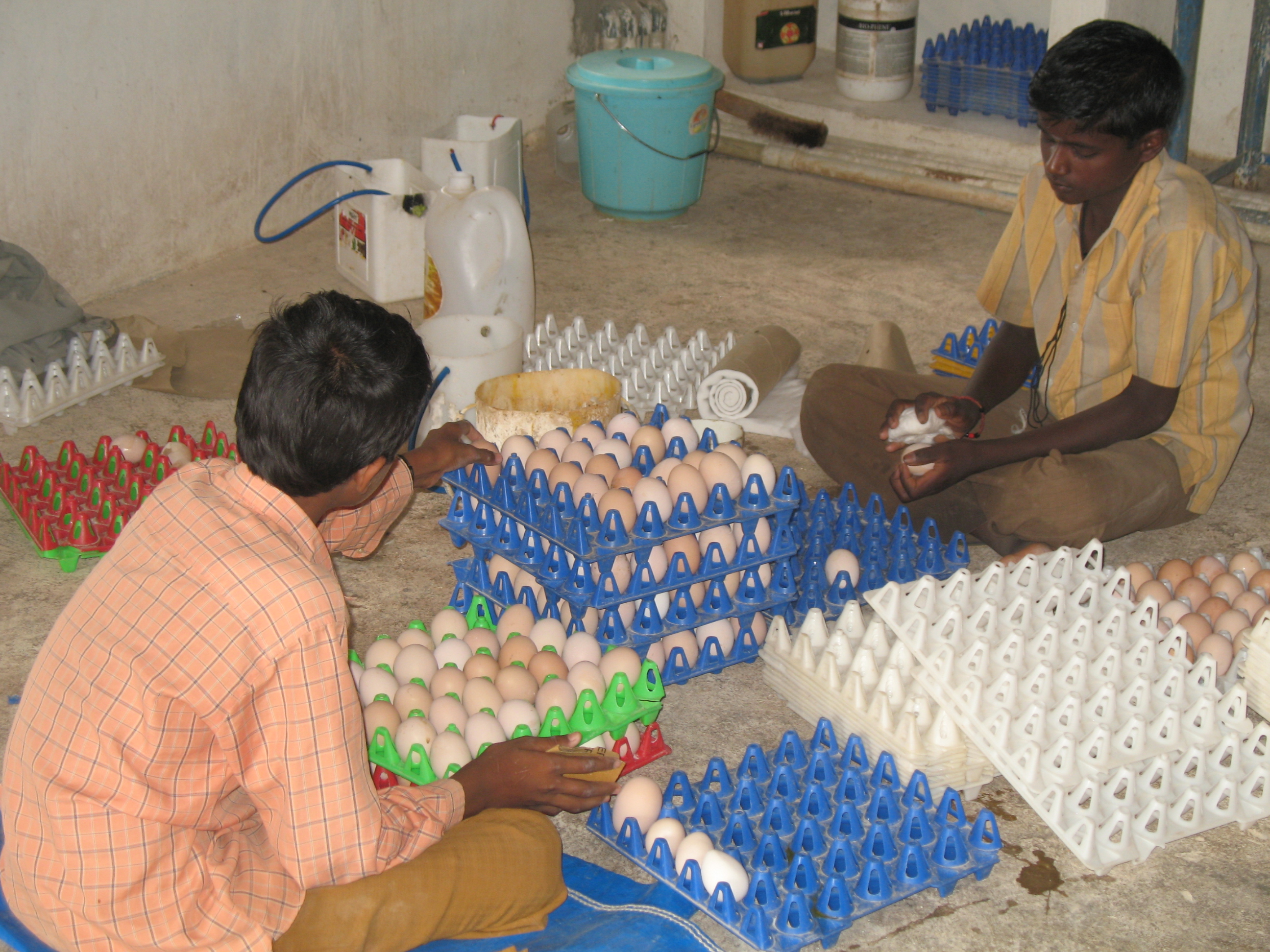Care of Laying Birds
Housing
At 18 weeks of age all under grown pullet chicks are to be culled and disposed off. Careful selection at the time of housing enables better returns and fewer culls later. The stock can either be reared in the same house where it was grown or transferred to laying house. Optimum housing density should be maintained for best utilization of house, equipment and labour. Provide 65 feet of floor space per egg type bird. Nest boxes must be introduced to laying house two weeks prior to the onset of lay to help birds to get used to nest. The nests should be roomy, dark, cool, well ventilated and located on one side of the building. Nest boxes made of cheap deal wood, measuring 30 x 30 x 40 cm each may be provided at the rate of one box for every five hens. Clean nesting materials should be placed inside the nest boxes and the nesting materials should be changed periodically. If needed, top-dress the litter with new material.

Laying Bird
Light: Use correct lighting schedule to ensure better performance. While light period should not be increased for growing birds, it would be advantageous to increase the light period or photoperiod for laying chicken from 22nd week of age onwards at the rate of 15 minutes per week so as to reach 16 hours of total photoperiod (natural plus artificial). When the birds have been in lay for about 6 months, the photoperiod may be increased to 17 hours per day. The light period may be constantly maintained throughout the rest of laying period. There is no special advantage in increasing the photoperiod over 17 hours per day. The lighting programme, if started, should be followed systematically.
Feeding: A good quality layer mash should be provided to the laying birds.
Ration of layer mash for chickens
| Ingredients |
Percentage |
| Yellow Maize |
47 |
| Soyabean meal |
12 |
| Gingelly oil cake |
4 |
| Groundnut oil cake (expeller) |
6 |
| Rice polish |
13 |
| Wheat bran |
4 |
| Fish meal/dried unsalted fish |
6 |
| Dicalcium phosphate |
1 |
| Salt |
0.25 |
| Mineral mixture |
1.75 |
| Shell meal |
5 |
| Total |
100.00 |
The feed may be given in linear feed troughs or in hanging feeders. Provide five hanging feeders, each 50 cm in diameter with 20 – 25 kg capacity for 100 layers. Place the feeders within 3 meters of water. Stir the feed few times a day to promote eating.
Water space of 2.5 linear cm per bird should be provided. Increase watering space 25% when temperature goes above 27oC. The feeders in the laying pen must be positioned in such a way that the upper edge is slightly higher than the back of the birds. The feeders should not be filled more than 1/3 full.
Cage Layer Management
The advantages of cage rearing are easy management, housing of more number of birds in limited space, clean egg production, less problem due to parasites and other diseases, easier culling, etc. Some of the disadvantages include high initial investment, wet dropping, odour and fly problem. To offset these problems, elevated cage houses are useful.

Four birdcages are ideal for commercial layers. The specification of a 4 bird cage is as follows.
| Length (Frontage) |
45 cm |
| Height at back |
38 cm |
| Height at front |
42 cm |
| Width |
42 cm |
Since there are two different measurements in height, the floor of the cage will have a slope towards front. Most material for laying cage floors is welded wire fabric. Sometimes the wire is coated with plastic. Most cage floors are constructed of 14 gauge wire to give necessary strength. Usually cage floors are constructed of wire with a mesh size of 2.5 x 5.0 cm (1 x 2"). The wire floor should be extended past the front of the cage for 18 cm and rounded up so as to collect the eggs there. To conserve space, thereby reducing the investment in the house in which the laying cages are placed, many methods have been developed to house birds in a given area. Single-deck, double-deck or triple-deck arrangement can be adopted.
The floor of the cage should be about one meter higher than the ground level. In order to collect the droppings from the cages a shallow pit at a depth of 30 cm from the floor level at length-wise just under the cages may be constructed.
Long, continuous troughs are used for feeding caged layers. Water is supplied by channel running the length of the cage unit. The water channel is usually placed above the feed trough outside the cage. Instead of water channel, nipple drinkers can also be provided. Birds should be dewormed once in every 3 months.
Breeder management: Breeding birds are reared for the production of hatching eggs. Care should be taken to produce maximum fertile eggs that hatch well. For this purpose males should be reared separately from the females during the growing period. Breeder males should be introduced to the flock of females at 20 weeks of age in the ratio of 1 : 8 for heavy breeds and 1:10 for light breeds. Hatching eggs can be saved from the age of 24 weeks onwards. The birds must be kept free of Pullorum disease and Mycoplasmosis.
Clean and dry litter is necessary to produce clean eggs with good hatchability and to improve general health of birds. The hatching eggs should be fresh and with good shell quality. Hair like cracks on the egg shell will reduce hatchability. Nests should be provided at the rate of one per five birds.
Breeding birds should be given breeder mash or a layer mash supplemented with MnSO4, Choline Chloride, Selenium, Vit. E, Lysine and Methionine as per standards.
Feed restriction in meat type breeders: Meat type breeders have the inherent ability to grow faster. There is a negative correlation between the body weight and reproductive capacity. Hence top priority should be given to control the body weight of broiler breeders during growing and laying phases so as to get maximum production and profit.
Advantages of feed restriction
- Uniformity in the flock.
- Produces better egg size during early periods of laying.
- Reduces body weight at sexual maturity.
- Offers better livability during egg production.
- Avoid problems of fertility and hatchability.
- Leg disorders due to over feeding can be controlled.
- Mortality due to over feeding will be prevented.
- Avoid mating difficulties due to their large body size in males.
Methods of feed restriction
There are two methods of feed restriction
- Restrict the daily amount of feed given to the bird considering the body weight standards of the particular breed.
- Skip a day feeding either by feeding every alternate day or by skip feeding one day per week.
The weekly body weight record is the main criterion for the feed restriction programme. So sample of birds should be weighed on weekly basis and this weight can be compared with that of the standards for those particular breeds. If the body weight is below the standards the feed allotments must be increased.
(Source: Kerala Agricultural University)
Culling: Year round culling of unproductive stock will fetch better profit. Culling is based on physical characters, which reflect the physiological changes related to egg production.
Culling for better returns
Birds which do not perform well are culled to optimize profits. Culling is practiced on the basis of outward appearance of available records. Stunted growth and physical deformity do not pose any problem. Culling for poor production or non-production requires handling of all the stocks in the laying pen. Since culling may be a source of annoyance to the flock thereby causing a drop in production it should be practiced in the night.
Culling from outward Appearance
The appearance of a bird though not an index of its laying ability gives an idea about its health and vigour. The main characteristic for distinguishing a layer from a non-layer is given below.
| Character |
Laying hen |
Non-laying hen |
| Comb and wattle |
Full, red, waxy, warm and velvet like |
dry, hard cold, coarse and shrunken with white scabs |
| Beak |
Stocky, well curved, worn -out and less yellow |
Very long, thin and sharp pointed, yellow |
| Eyes |
Bright and alert |
Dull and sleepy |
| Ear lobes |
Full, waxy and velvet like |
Shrunken, wrinkled and coarse |
| Pelvic bones |
Usually spread apart more than 2 fingers, thin and pliable |
practically close together thick and stiff |
| Abdomen |
Large, spread 3 to 5 fingers, soft and less of fat |
Small usually less than 2 fingers, hard and more of fat |
| Vent |
Full, large and moist |
Small, dry and puckered |
Culling on the Basis of Moulting:
Moulting which refers to the shedding of feathers provides some indication about the laying capacity of a bird. Good layers not only moult late but also complete the moulting period quickly and sometimes continue to lay even during moulting. Poor layers on the other hand moult early, take a long time to complete the process and do not lay any eggs during the moulting period. It is possible to determine the beginning of moulting by counting the stiff primary feathers in the wing. The first one to be dropped is the inner one next to the axial feather which separates the primate is from the secondaries. It takes about 6 weeks for the first new primary feather and 2 weeks for each additional full-grown feather. A wing having 4 new primaries during moulting season indicates that the bird has been in moulting for 12 weeks.
Laying flocks are generally to be liquidated after one year of production, since keeping them longer into second year of production may be uneconomical. If there is any outbreak of vertically transmitted diseases, like salmonellosis, total culling is recommended.
(Source: Dr.Acharya, Handbook of Animal Husbandry)
Care of eggs: Eggs produced under clean conditions are most profitable. To produce table eggs keep males out of flock. Fertile eggs deteriorate more quickly than infertile eggs. Provide clean good litter material in the nest boxes. Collect eggs as frequently as possible at least 3 times a day and keep them cool until they are disposed off. In warm weather increase collection to four or five times a day.
Handle eggs carefully. Collect the eggs in clean filler flats or in well-ventilated wire plastic baskets. Market eggs frequently. If the percentage of dirty eggs is more, check the management of layer house and take corrective measures.

Summer management: Chickens prefer a laying house temperature of about 23.8oC and are comfortable up to 29.4oC. When the laying house temperature is above 32.3oC, birds are uncomfortable and the feed consumption is greatly reduced with low egg production. Over 37.8oC, the mortality rate is rather high. Coupled with these, the farmer often faces low egg prices also. Therefore adequate protection of laying birds during hot weather is emphasized.
The following tips are recommended to keep the birds comfortable and to curtail deaths during summer months.
- Provide plenty of clean, cool drinking water at all times. Crushed ice may be provided in waters if possible.
- Plant shade trees around the poultry house.
- Use a hosepipe sprinkler on the roof. Sprinkling can reduce temperature inside the house.
- Clean the wire netting regularly to maintain perfect ventilation.
- Reduce the thickness of old built-up litter. Two inches of fresh litter may be provided in the place of old litter.
- Preferable to give artificial light in the early morning hours so that birds eat and drink more during the cooler hours of the day.
- Provide plenty of soluble grit so that the hens can adjust their calcium intake. This will save a lot of cracked and broken eggs.
- Addition of electrolytes, Vitamin C, and probiotic in drinking water helps to alleviate heat stress.
- Provide fan ventilation during summer.
- Feed during cool hours of the day. Addition of vitamins and minerals in the feed is advantageous.
- Hang wet gunny bags on the sides.
- Provide sprinklers in the pen.
(Source: www.vuatkerala.org )
|